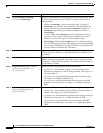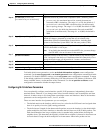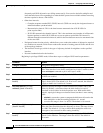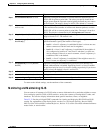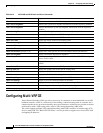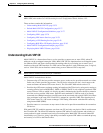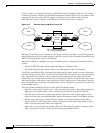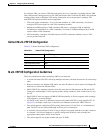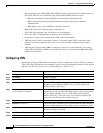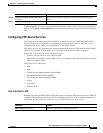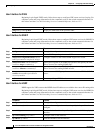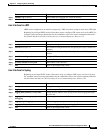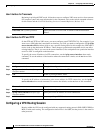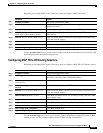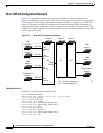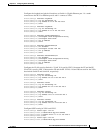
35-78
Cisco ME 3400 Ethernet Access Switch Software Configuration Guide
OL-9639-06
Chapter 35 Configuring IP Unicast Routing
Configuring Multi-VRF CE
• Most routing protocols (BGP, OSPF, RIP, EIGRP, and static routing) can be used between the CE
and the PE. However, we recommend using external BGP (EBGP) for these reasons:
–
BGP does not require multiple algorithms to communicate with multiple CEs.
–
BGP is designed for passing routing information between systems run by different
administrations.
–
BGP makes it easy to pass attributes of the routes to the CE.
• Multi-VRF CE does not affect the packet switching rate.
• If no VRFs are configured, up to 105 policies can be configured.
• If even one VRF is configured than 41 policies can be configured.
• If more than 41 policies are configured then VRF cannot be configured.
• VRF and private VLANs are mutually-exclusive. You cannot enable VRF on a private VLAN.
Similarly, you cannot enable private VLAN on a VLAN with VRF configured on the VLAN
interface.
• VRF and policy-based routing (PBR) are mutually-exclusive on a switch interface. You cannot
enable VRF when PBR is enabled on an interface. In contrast, you cannot enable PBR when VRF is
enabled on an interface.
Configuring VRFs
Beginning in privileged EXEC mode, follow these steps to configure one or more VRFs. For complete
syntax and usage information for the commands, refer to the switch command reference for this release
and the Cisco IOS Switching Services Command Reference, Release 12.2.
Command Purpose
Step 1
configure terminal Enter global configuration mode.
Step 2
ip routing Enable IP routing.
Step 3
ip vrf vrf-name Name the VRF, and enter VRF configuration mode.
Step 4
rd route-distinguisher Create a VRF table by specifying a route distinguisher. Enter either an
AS number and an arbitrary number (xxx:y) or an IP address and
arbitrary number (A.B.C.D:y)
Step 5
route-target {export | import | both}
route-target-ext-community
Create a list of import, export, or import and export route target
communities for the specified VRF. Enter either an AS system number
and an arbitrary number (xxx:y) or an IP address and an arbitrary
number (A.B.C.D:y). The route-target-ext-community should be the
same as the route-distinguisher entered in Step 4.
Step 6
import map route-map (Optional) Associate a route map with the VRF.
Step 7
interface interface-id Specify the Layer 3 interface to be associated with the VRF, and enter
interface configuration mode. The interface can be a routed port or SVI.
Step 8
no shutdown Enable the interface if necessary. By default, UNIs and ENIs are
disabled and NNIs are enabled.
Step 9
ip vrf forwarding vrf-name Associate the VRF with the Layer 3 interface.
Step 10
end Return to privileged EXEC mode.



